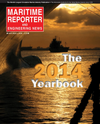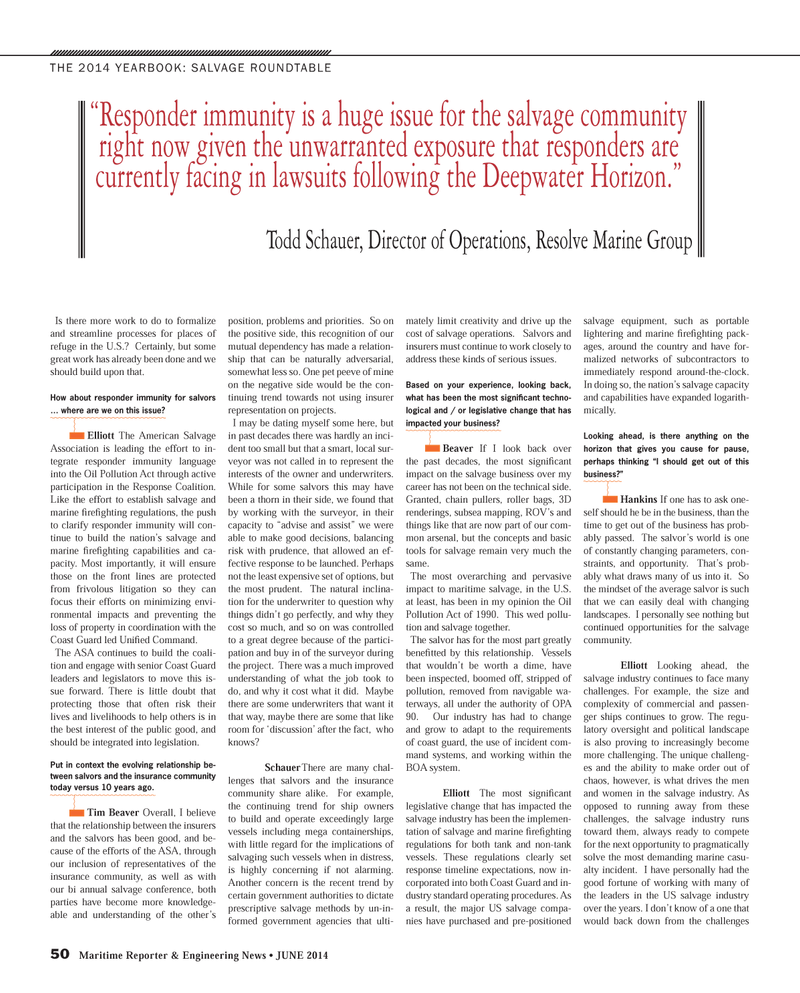
Page 50: of Maritime Reporter Magazine (June 2014)
Annual World Yearbook
Read this page in Pdf, Flash or Html5 edition of June 2014 Maritime Reporter Magazine
50 Maritime Reporter & Engineering News • JUNE 2014
Is there more work to do to formalize and streamline processes for places of refuge in the U.S.? Certainly, but some great work has already been done and we should build upon that.
How about responder immunity for salvors … where are we on this issue?
Elliott The American Salvage
Association is leading the effort to in- tegrate responder immunity language into the Oil Pollution Act through active participation in the Response Coalition.
Like the effort to establish salvage and marine ? re? ghting regulations, the push to clarify responder immunity will con- tinue to build the nation’s salvage and marine ? re? ghting capabilities and ca- pacity. Most importantly, it will ensure those on the front lines are protected from frivolous litigation so they can focus their efforts on minimizing envi- ronmental impacts and preventing the loss of property in coordination with the
Coast Guard led Uni? ed Command.
The ASA continues to build the coali- tion and engage with senior Coast Guard leaders and legislators to move this is- sue forward. There is little doubt that protecting those that often risk their lives and livelihoods to help others is in the best interest of the public good, and should be integrated into legislation.
Put in context the evolving relationship be- tween salvors and the insurance community today versus 10 years ago.
Tim Beaver Overall, I believe that the relationship between the insurers and the salvors has been good, and be- cause of the efforts of the ASA, through our inclusion of representatives of the insurance community, as well as with our bi annual salvage conference, both parties have become more knowledge- able and understanding of the other’s position, problems and priorities. So on the positive side, this recognition of our mutual dependency has made a relation- ship that can be naturally adversarial, somewhat less so. One pet peeve of mine on the negative side would be the con- tinuing trend towards not using insurer representation on projects.
I may be dating myself some here, but in past decades there was hardly an inci- dent too small but that a smart, local sur- veyor was not called in to represent the interests of the owner and underwriters.
While for some salvors this may have been a thorn in their side, we found that by working with the surveyor, in their capacity to “advise and assist” we were able to make good decisions, balancing risk with prudence, that allowed an ef- fective response to be launched. Perhaps not the least expensive set of options, but the most prudent. The natural inclina- tion for the underwriter to question why things didn’t go perfectly, and why they cost so much, and so on was controlled to a great degree because of the partici- pation and buy in of the surveyor during the project. There was a much improved understanding of what the job took to do, and why it cost what it did. Maybe there are some underwriters that want it that way, maybe there are some that like room for ‘discussion’ after the fact, who knows?
Schauer There are many chal- lenges that salvors and the insurance community share alike. For example, the continuing trend for ship owners to build and operate exceedingly large vessels including mega containerships, with little regard for the implications of salvaging such vessels when in distress, is highly concerning if not alarming.
Another concern is the recent trend by certain government authorities to dictate prescriptive salvage methods by un-in- formed government agencies that ulti- mately limit creativity and drive up the cost of salvage operations. Salvors and insurers must continue to work closely to address these kinds of serious issues.
Based on your experience, looking back, what has been the most signifi cant techno- logical and / or legislative change that has impacted your business?
Beaver If I look back over the past decades, the most signi? cant impact on the salvage business over my career has not been on the technical side.
Granted, chain pullers, roller bags, 3D renderings, subsea mapping, ROV’s and things like that are now part of our com- mon arsenal, but the concepts and basic tools for salvage remain very much the same.
The most overarching and pervasive impact to maritime salvage, in the U.S. at least, has been in my opinion the Oil
Pollution Act of 1990. This wed pollu- tion and salvage together.
The salvor has for the most part greatly bene? tted by this relationship. Vessels that wouldn’t be worth a dime, have been inspected, boomed off, stripped of pollution, removed from navigable wa- terways, all under the authority of OPA 90. Our industry has had to change and grow to adapt to the requirements of coast guard, the use of incident com- mand systems, and working within the
BOA system.
Elliott The most signi? cant legislative change that has impacted the salvage industry has been the implemen- tation of salvage and marine ? re? ghting regulations for both tank and non-tank vessels. These regulations clearly set response timeline expectations, now in- corporated into both Coast Guard and in- dustry standard operating procedures. As a result, the major US salvage compa- nies have purchased and pre-positioned salvage equipment, such as portable lightering and marine ? re? ghting pack- ages, around the country and have for- malized networks of subcontractors to immediately respond around-the-clock.
In doing so, the nation’s salvage capacity and capabilities have expanded logarith- mically.
Looking ahead, is there anything on the horizon that gives you cause for pause, perhaps thinking “I should get out of this business?”
Hankins If one has to ask one- self should he be in the business, than the time to get out of the business has prob- ably passed. The salvor’s world is one of constantly changing parameters, con- straints, and opportunity. That’s prob- ably what draws many of us into it. So the mindset of the average salvor is such that we can easily deal with changing landscapes. I personally see nothing but continued opportunities for the salvage community.
Elliott Looking ahead, the salvage industry continues to face many challenges. For example, the size and complexity of commercial and passen- ger ships continues to grow. The regu- latory oversight and political landscape is also proving to increasingly become more challenging. The unique challeng- es and the ability to make order out of chaos, however, is what drives the men and women in the salvage industry. As opposed to running away from these challenges, the salvage industry runs toward them, always ready to compete for the next opportunity to pragmatically solve the most demanding marine casu- alty incident. I have personally had the good fortune of working with many of the leaders in the US salvage industry over the years. I don’t know of a one that would back down from the challenges
THE 2014 YEARBOOK: SALVAGE ROUNDTABLE “Responder immunity is a huge issue for the salvage community right now given the unwarranted exposure that responders are currently facing in lawsuits following the Deepwater Horizon.”
Todd Schauer, Director of Operations, Resolve Marine Group
MR #6 (50-57).indd 50 6/9/2014 11:20:50 AM

 49
49

 51
51
